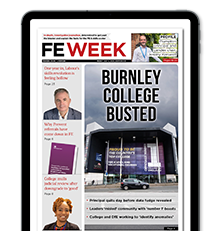Skills and apprenticeships minister, Robert Halfon grabbed our attention during his speech to the Annual Apprenticeship Conference when he told delegates: “To every young person I meet my message is that no matter who you are, or where you’re from, or whatever career you want to do, an apprenticeship will open doors for you.”
With 42 per cent of London Design and Engineering UTC’s learners eligible for pupil premium and 55 per cent speaking English as a second language, we understand the importance of helping young people from a range of backgrounds seize the opportunities that are out there for them.
My impact report on the school’s careers strategy reveals several interesting findings about the UTC’s employer engagement and offers some insights into how other practitioners can open the doors to apprenticeships, further education and employment to all their learners.
Quality and quantity
The report, carried out with the support of LDE’s leaders and its employer partners, found that our 569 students received an average of 19 encounters with employers during 2020/21. The target under the Gatsby benchmarks is just one.
The tremendous work of staff to achieve this has rightly been recognised. Employer engagement manager Janice Tricks’ work bringing employers and students together was cited three times during an Education Select Committee hearing last November.
But more than quantity, it’s the breadth and depth of that engagement that is the real key to success. Skanska ran mental health and wellbeing sessions for years 12 and 13. National Grid embedded power engineering sessions in year 9 science lessons. With CVB, the Costain Vinci Construction Grands Projects and Bachy Soletanche JV, Tideway, which is building the ‘Super Sewer’ under London, offered advice and support about job roles where A level students could apply their maths skills.
More than two-thirds (68 per cent) of learners agreed or strongly agreed that they had met a whole range of employers at the school.
A culture of engagement
The essential ingredients of a UTC also produce results. Associate principal, James Culley told the report students are “part of a professional working environment”, allowing them to “slowly develop confidence” and their employability skills on a day-to-day basis.
This is achieved through work experience opportunities, but also by the UTC keeping office hours rather than traditional school hours and by students learning on industry-standard equipment with expert teachers.
Ninety-four per cent of learners agreed that they were given information on apprenticeship vacancies at the UTC. The same proportion of our school leavers said that they had been given good advice on how to apply for apprenticeships and other opportunities.
One of LDE’s alumni, who now works as an apprentice site engineer, gave us a brilliant illustration of the importance of believing in our learners and presenting them with opportunities beyond the curriculum. In the report, he was glowing about having had the chance to meet ministers and take part in radio and TV interviews as one of our student ambassadors.
Getting started
Our research has led us to several recommendations for how employers, learners, and providers can create a more effective engagement programme.
For employers, governorship roles can provide valuable insights into a provider’s potential and how their projects can fit with the provider’s curriculum. Bringing employers on in this way can also help to create a sense of mutual endeavour.
For learners and families, tracking employer engagements is a powerful measure of how much they are creating opportunities for themselves. It’s also an important addition to their CV. Work experience opportunities are out there, and directing them to sites like LinkedIn is a great place to start.
For colleges and training providers, maintaining long-term employer relationships is key. To make the most of those relationships, leaders should support employers to develop projects for students and support staff to use employer engagement across the curriculum.
Perhaps the best piece of advice is from our apprentice site engineer: “You’ve got to want to do things”.
We all want what Robert Halfon wants: Apprenticeships that deliver opportunity for all. Now, we have the tools to make it happen.

















Your thoughts